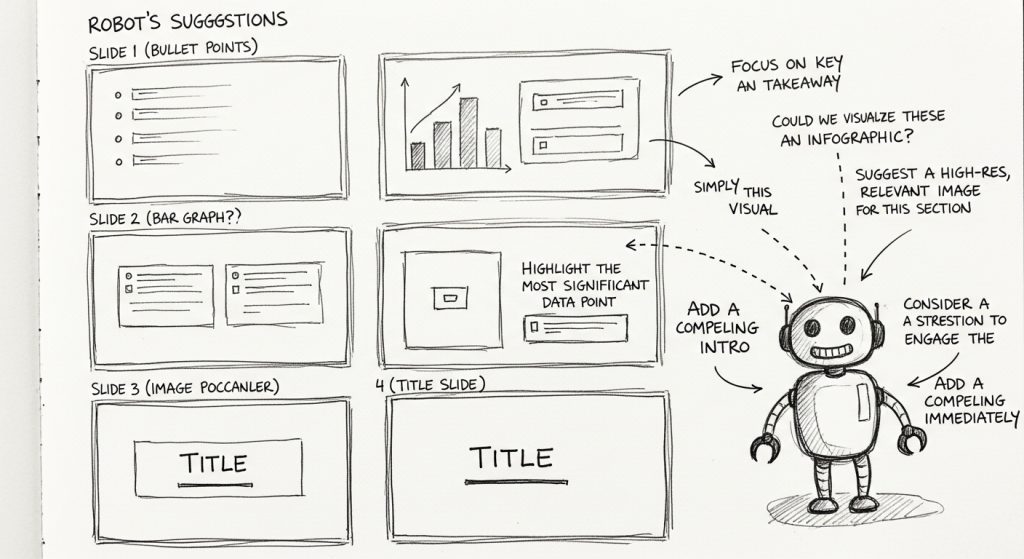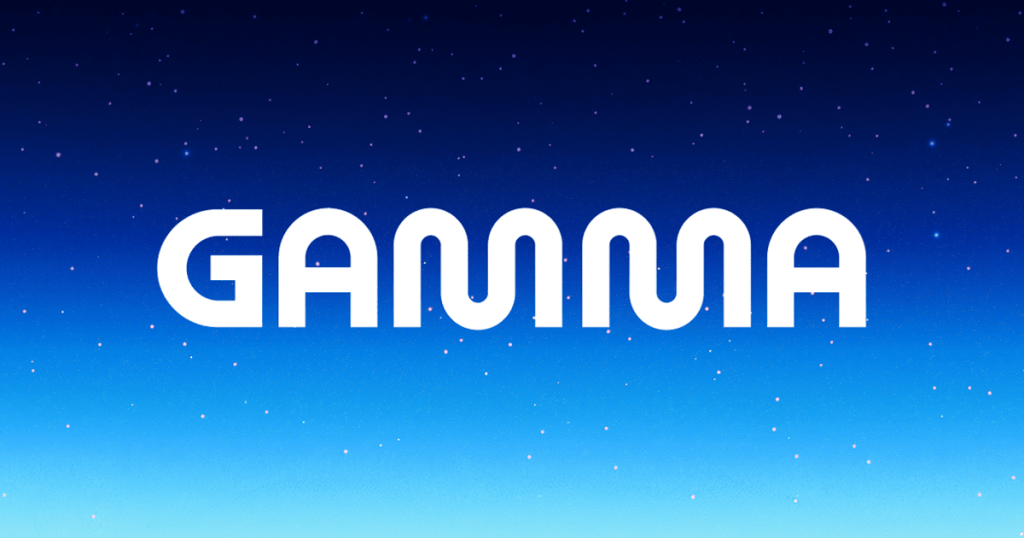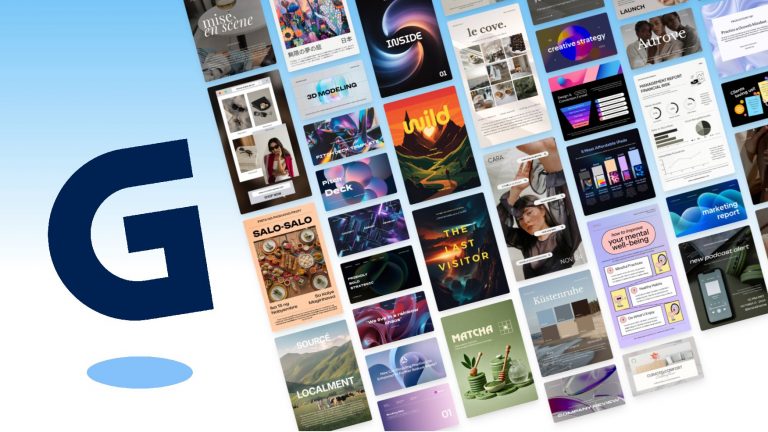The Absolute Best AI Tools for Presentations in 2025
Staring at a blank slide? Discover the best AI tools for presentations in 2025. I’ll review top picks like Gamma and Tome to help you create stunning decks in minutes.
I get it. You’ve been tasked with creating a “quick” presentation. But it’s never quick, is it? You spend the first hour just staring at a blank PowerPoint screen, trying to figure out where to even begin. Then comes the endless fiddling with text boxes, searching for non-cheesy stock photos, and trying to make your slides look like they were designed in this century.
Time is everyone’s most valuable asset. I’d rather spend it on strategy and storytelling than on aligning logos and picking font sizes. For years, this was just a frustrating part of the job. But not anymore.
The game has completely changed. AI-powered presentation tools are here, and they are one of the biggest productivity hacks I’ve found in my entire career. They don’t just speed up the process; they elevate the final product, turning basic outlines into compelling, beautifully designed narratives. I’m talking about going from a simple prompt to a polished, client-ready deck in minutes.
Ready to stop wasting time and start creating presentations that actually impress? I’ve personally tested the top contenders to bring you the definitive guide to the best AI tools for presentations in 2025.
What are AI Presentation Tools?
At its core, an AI presentation tool is a type of software that uses artificial intelligence to automate the creation and design of slide decks. Instead of building each slide manually, you provide the AI with a starting point—like a simple text prompt, a document, or an outline—and it generates a complete, formatted presentation for you. Think of it as having a creative sidekick who handles all the tedious design work, letting you focus on the story you want to tell.

These tools go beyond just creating slides. They can suggest layouts, generate relevant images, rewrite text for a specific tone, and ensure your entire deck is visually consistent. The goal is to dramatically reduce the time it takes to create a professional-quality presentation.
Why AI Presentation Tools Matter in 2025
The demand for high-quality, engaging content is higher than ever, but our time is constantly shrinking. In 2025, efficiency isn’t just a buzzword; it’s a survival strategy. AI presentation tools are no longer a novelty—they’re becoming essential for a few key reasons:
- Speed and Efficiency: A survey revealed that over 60% of people spend at least a couple of hours on a simple 10-slide presentation. AI tools can shrink that time down to mere minutes.
- Design for Everyone: You no longer need a design degree to create a beautiful deck. These tools democratize good design, making sure even the most design-challenged among us can make polished, professional-looking slides.
- Enhanced Engagement: Many AI tools allow for the embedding of interactive elements like videos, polls, and live web content, making presentations more dynamic and engaging for the audience.
- Brand Consistency: For teams, maintaining a consistent brand look is crucial. Top AI tools allow you to set up brand kits with your company’s logos, colors, and fonts, ensuring every presentation is perfectly on-brand.
The Best AI Tools for Presentations (Ranked & Reviewed)
I’ve put the most popular AI presentation makers to the test. Here’s my honest breakdown of the best tools on the market right now, who they’re for, and what they do best.

1. Gamma: Best All-Rounder for Speed and Interactivity
Gamma has quickly become my go-to for creating fast, modern, and engaging presentations. It’s less like a traditional slide-by-slide tool and more like creating an interactive webpage or document. You give it a prompt, and it generates an entire, scrollable “card-style” deck in seconds.
Key Features:
- AI-First Generation: Gamma’s core strength is its ability to create a full presentation from a single prompt or pasted document. It generates an outline first, which you can edit before it builds the slides.
- One-Click Restyling: Don’t like the theme? You can change the entire look and feel of your deck with a single click without messing up your content.
- Interactive Embeds: This is where Gamma really shines. You can easily embed videos, GIFs, charts, and even full websites directly into your cards.
- Built-in Analytics: Track how people engage with your presentation, see which cards they spend the most time on, and gather feedback.
Who It’s Best For:
Startups, marketers, and educators who need to create visually impressive, web-based presentations quickly. It’s perfect for anyone who hates PowerPoint and wants a more modern way to share ideas.
Pricing:
- Free Plan: Offers 400 AI credits to start (but they don’t refresh) and allows for unlimited users and Gamma-branded decks.
- Plus Plan: $10/month for more AI credits and premium templates.
- Pro Plan: $20/month for unlimited AI creation, advanced branding options, and priority support.
2. Tome: Best for AI-Powered Storytelling and Collaboration
(Update: Tome has shifted their focus and moved away from presentation solutions)
Tome positions itself as an “AI-powered storytelling” tool, and it lives up to the hype. It excels at turning your ideas into a compelling narrative, generating not just slides but a coherent story with AI-generated text and images. It’s an excellent tool for teams that need to collaborate on high-stakes presentations.

3. Beautiful.ai: Best for Enforcing Brand Consistency and Design Rules
Beautiful.ai takes a different approach. Its strength isn’t in generating your content from scratch, but in automating the design process. It operates on “smart slides” that automatically adapt as you add content, ensuring every slide looks professionally designed. Think of it as having a designer built into the software.
Key Features:
- Smart Slide Templates: The core of the platform. You choose a layout (like a timeline or a comparison table), and it automatically formats your content perfectly. Add another bullet point, and the whole slide rebalances itself.
- Design Automation: The AI enforces design rules, so you can’t make a “bad” slide. It handles alignment, spacing, and font sizes for you.
- Branding Control: The Team plan is fantastic for businesses. You can lock in your company’s fonts, colors, and logos to ensure every presentation is on-brand.
- Recent UI Update (2025): A new, more intuitive interface was rolled out in early 2025, making all controls more accessible and streamlining the workflow.
Who It’s Best For:
Corporate teams, businesses, and individuals who prioritize a polished, consistent brand image over complete creative freedom. It’s for people who want beautiful slides without fiddling with design.
Limitations:
The trade-off for perfect design automation is a lack of creative freedom. You are constrained by the template’s logic, which can be frustrating for users who want pixel-perfect control.
Pricing:
- Pro Plan: $12/month (billed annually) for individual users.
- Team Plan: $40/user/month (billed annually) for collaborative features and brand control.
- Single Presentation: A one-time fee of $45 for a single project.
Start Designing with Beautiful.ai

4. Canva Magic Design: Best for Existing Canva Users and Social Media Visuals
Canva is the design tool many of us already know and love. With Magic Studio, they’ve integrated AI features, including Magic Design for Presentations. If you’re already in the Canva ecosystem, this is a natural and powerful extension.
Key Features:
- Prompt-to-Deck Creation: Give Magic Design a prompt, and it will generate a short set of slides based on Canva’s vast template library.
- Integrated Ecosystem: The biggest advantage is access to Canva’s entire suite of tools—millions of stock photos, videos, graphics, and the Magic Write AI text generator.
- Brand Kit Integration: Seamlessly applies your Canva brand kit (logos, colors, fonts) to the generated presentations.
Who It’s Best For:
Marketers, social media managers, and small businesses who are already heavy Canva users. It’s great for creating quick, visually appealing decks that align with other marketing materials.
Limitations:
The AI-generated content can be quite basic and often requires significant editing. Some reviews note the text can be generic and the layouts repetitive, functioning more as nice-looking title slides than substantive content.
Pricing:
- Free Plan: Includes Magic Design with some limitations. Magic Media (AI image generator) offers 50 lifetime credits.
- Canva Pro: Around $12.99/month, which unlocks the full suite of Magic Studio tools and gives you more AI credits.
- Canva for Teams: Starts around $14.99/user/month for collaborative features.
Practical Use Cases for AI Presentation Tools
So, how does this actually work in the real world? Here are a few scenarios where these tools are lifesavers:
- The Last-Minute Sales Pitch: Your boss asks for a pitch deck for a new client… by the end of the day. Use Gamma or Tome to turn your rough notes into a polished, professional deck in under an hour.
- The Monthly Marketing Report: You need to present your monthly KPIs to leadership. Instead of wrestling with PowerPoint charts, use Beautiful.ai to create clean, on-brand data visualizations that look amazing.
- Brainstorming a New Campaign: You have an idea but need to flesh it out. Use Tome to type in a simple concept and let it generate a full narrative structure, complete with visuals, to help you brainstorm and present your initial thoughts.
- Creating Webinar or Course Content: As an educator or trainer, you can use Gamma to quickly generate engaging, interactive materials for your students that can be easily shared via a link.
- Social Media Visuals: Need a quick carousel post for Instagram that looks like a mini-presentation? Canva Magic Design is perfect for this, letting you create branded, bite-sized content in minutes.
Pros and Cons of Using AI for Presentations
Let’s be real—no tool is perfect. Here’s a balanced look at the good and the not-so-good.
| Pros | Cons |
|---|---|
| ✅ Massive Time Savings | ❌ Generic Content (AI text can lack depth and sound cliché) |
| ✅ Professional Design Quality (Even for non-designers) | ❌ Limited Customization (Can feel restrictive, especially Beautiful.ai) |
| ✅ Enforces Brand Consistency | ❌ Requires Fact-Checking (AI can confidently make things up) |
| ✅ Fosters Creativity (By handling the boring parts) | ❌ Internet-Reliant (Most tools are cloud-based and need a connection) |
| ✅ Easy Collaboration (Real-time editing on many platforms) | ❌ Privacy Concerns (Be careful with sensitive company data) |
Pro Tips for Getting the Most Out of Your AI Tool
I’ve learned a few things from making dozens of presentations with these tools. Here’s my best advice:
- Be a Great Director, Not Just a User: The AI is your assistant, not your replacement. Your job is to provide a clear, detailed prompt and then edit and refine the output. The better your input, the better the output.
- Start with an Outline: Don’t just give the AI a vague topic. Feed it a structured outline with your key talking points. This gives it a much better roadmap to follow.
- Fact-Check Everything: AI models can “hallucinate” and present incorrect information as fact. Always verify any data, stats, or claims the AI generates.
- Inject Your Own Voice: The AI-generated text is a great starting point, but it will always sound better if you go back and tweak it to match your personal tone and style.
- Use It for the First Draft, Not the Final Word: The single best use of these tools is to conquer the “blank page” problem. Let the AI get you 80% of the way there in minutes, then spend your valuable time on the final 20%—refining the story, adding key insights, and practicing your delivery.
Frequently Asked Questions (FAQ)
Can AI create a full presentation from a single prompt?
Yes, absolutely. Tools like Gamma and Tome are specifically designed to generate a complete, multi-slide presentation from a single text prompt. You describe your topic, and the AI builds the outline, writes the text, and finds relevant images.
Is the content generated by AI unique?
Mostly, but it’s complicated. The AI generates text based on patterns from vast amounts of data. While the specific combination of words is likely unique, the ideas and phrases can sometimes be generic or repetitive. It’s always best to edit and add your own unique insights.
Do I still need PowerPoint or Google Slides?
It depends. For many, especially those creating web-first, interactive presentations, these AI tools can completely replace traditional software. However, if you need highly complex animations, offline editing capabilities, or have strict corporate templates in PPTX format, you might still need to use PowerPoint for the final touches.
Your Secret Weapon for Incredible Presentations
Let’s be honest: in the world of marketing, perception is reality. A sharp, well-designed presentation signals competence and authority before you even say a word. For too long, creating that level of quality was a time-consuming chore.
Not anymore. The tools I’ve shared today are your new secret weapon. They are the fastest way to go from a nagging task on your to-do list to a stunning presentation that makes you look like a rockstar. Stop dreading your next presentation and start creating something you’re genuinely excited to share.
Pick the tool that best fits your workflow and give it a try. You’ll be amazed at how much time you save and how much better your decks look.







